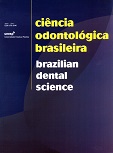Adição de própolis ao hidróxido de cálcio e sua influência na ação antibacteriana
DOI:
https://doi.org/10.14295/bds.2008.v11i3.512Abstract
ResumoO objetivo deste estudo foi avaliar o efeito de duas diferentes concentrações de própolis em extrato etanólico sobre a ação antibacteriana do hidróxido de cálcio (Ca(OH)2). Foram preparadas suspensões contendo 108 células/mL das bactérias Gram positivas Enterococcos faecalis; Staphylococcus aureus; Staphylococcus saprophyticus e Gram negativas Pseudomonas aeruginosa e Escherichia coli. Alíquotas de 0,1 mL das suspensões foram semeadas em duplicata, em agar Muller Hinton. Discos de papel de filtro foram embebidos em extratos etanólicos de própolis a 20 e 40%; em Ca(OH)2 preparado com os referidos extratos de própolis e Ca(OH)2 preparado em solução fisiológica, sendo em seguida posicionados sobre o ágar. As placas foram incubadas a 37°C/24h e após este período, os halos de inibição do crescimento bacteriano foram medidos. Através do teste de ANOVA one way verificou-se que Ca(OH)2 em solução fisiológica mostrou maior halo de inibição do crescimento bacteriano (p<0.001) em comparação com o hidróxido de cálcio preparado com própolis. A presença de própolis diminuiu a ação antibacteriana do Ca(OH)2 puro em pó tanto frente a bactérias Gram positiva quanto Gram negativa (p<0.001). Os resultados sugerem e estudos posteriores devem verificar se a característica resinosa da própolis pode ter dificultado a difusão e conseqüente ação antibacteriana do Ca(OH)2.
Downloads
Downloads
Published
How to Cite
Issue
Section
License
Brazilian Dental Science uses the Creative Commons (CC-BY 4.0) license, thus preserving the integrity of articles in an open access environment. The journal allows the author to retain publishing rights without restrictions.
=================




























